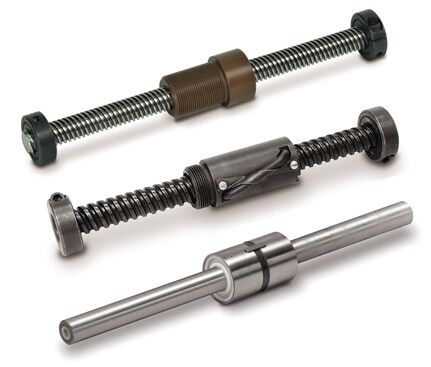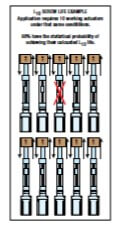How to Calculate Electric Linear Actuator Lifespan
By Ryan Klemetson on April 21, 2020
 “How long will it last?” Every machine design engineer gets asked this question and has to calculate the anticipated life of their machine—life that’s based on machine components including electric linear actuators. Also, expected service life is a factor engineers consider when they’re evaluating competing components.
“How long will it last?” Every machine design engineer gets asked this question and has to calculate the anticipated life of their machine—life that’s based on machine components including electric linear actuators. Also, expected service life is a factor engineers consider when they’re evaluating competing components.
Calculating electric linear actuator lifespan is fairly straightforward for ball screw and roller screw actuators — you use the L10 life formula for ball bearings. The life calculation for electric linear actuators focuses on these rolling elements because the screw/nut combination is a screw-driven electric linear actuator’s critical moving component.
Below we summarize the common methodology of this linear actuator lifespan calculator.
If you’d like more examples of these formulas in action, check out our Actuator Life Guide.
Definitions
Here are definitions of critical terms you’ll need to know.
- Dynamic Load Rating (DLR): This number is usually provided by the manufacturer and is represented by the letter C. It represents a constant
 load under which a ball bearing device will achieve 1,000,000 revolutions (rotations) of rated life.
load under which a ball bearing device will achieve 1,000,000 revolutions (rotations) of rated life. - Constant load: This is a load that remains unchanged along the full working cycle.
- Varying Load: A load that changes during the working cycle.
- Equivalent Dynamic Load: Equivalent dynamic load is a dynamic load acting on the screw which, if applied constantly, would have the same effect on screw life as the combined actual loads. When an application has a varying load, you have to calculate the equivalent dynamic load or Pe. In the case of constant load, equivalent load = actual load.
- L10 (or B10) Life: L10 is a calculation of life at which 10% of bearings in the same application can be expected to fail due to classic fatigue failure. L10 life for a group of identical screw actuators operating under the same conditions is the
 number of revolutions (or distance of travel) which 90% of these actuators have the statistical probability to achieve.
number of revolutions (or distance of travel) which 90% of these actuators have the statistical probability to achieve.
This calculation provides a theoretical life estimate based on a collection of statistics. It’s not a guarantee of performance but a guide for expected life.
How to Calculate L10 Life with a Constant Load
To estimate the lifespan of a ball or roller screw electric linear actuator that bears a constant load, you’ll want to start with the following formula:
L10 = (C/Pe)3 x l
C = Dynamic load rating (lbf) or (N)
Pe = Equivalent load (lbf) or (N)
l = Screw lead (in/rev) or (mm/rev)
For example, in a case where:
C = 10,000 lbf
Pe = 5,000 lbf
l = 5 mm
L10 = (10,000/5,000)3 x 5 =
(2)3 x 5 =
8 x 5=
40 =
40 million mm
How to Calculate L10 Life with a Varying Load
When a load varies during the working cycle you first have to calculate the equivalent dynamic load (Pe) using this formula:
Pe = 3 √{ [L1(P1)3+L2(P2 )3+L3(P3 )3+Ln(Pn )3]/L}
Pe = Equivalent load (lbs) or (N)
Pn = Each increment at different load (lbs) or (N)
L = Total distance traveled per cycle (extend + retract stroke) (L = L1 + L2 + L3 + Ln)
Ln = Each increment of stroke (in) or (mm) at different load
Then you can use the calculated Pe in the life calculation formula:
L10 = (C/Pe)3 x l
How to Calculate the Lifespan of Your Electric Linear Actuator in Time
Here’s how you calculate the lifespan of your electric linear actuator in terms of minutes, hours, days and years:
L10 life calculation in distance
L total distance traveled per cycle (extend + retract stroke)
CpM Number of cycles per minute
HpD Number of hours operated per day
DpY Number of days of operation per year
Put that information into one of these formulas to get your estimated lifespan:
Life Estimate in Years =
(L10 / L) / [(CpM) X 60 min/hr X (HpD) X (DpY)]
Life Estimate in Days =
(L10 / L) / [(CpM) X 60 min/hr X (HpD)]
Want to Learn More?
If you have any more questions about how to use our linear actuator lifespan calculator formulas, you’re welcome to speak directly with one of our application engineers.
Otherwise, you can learn more by downloading our Actuator Life Guide.
